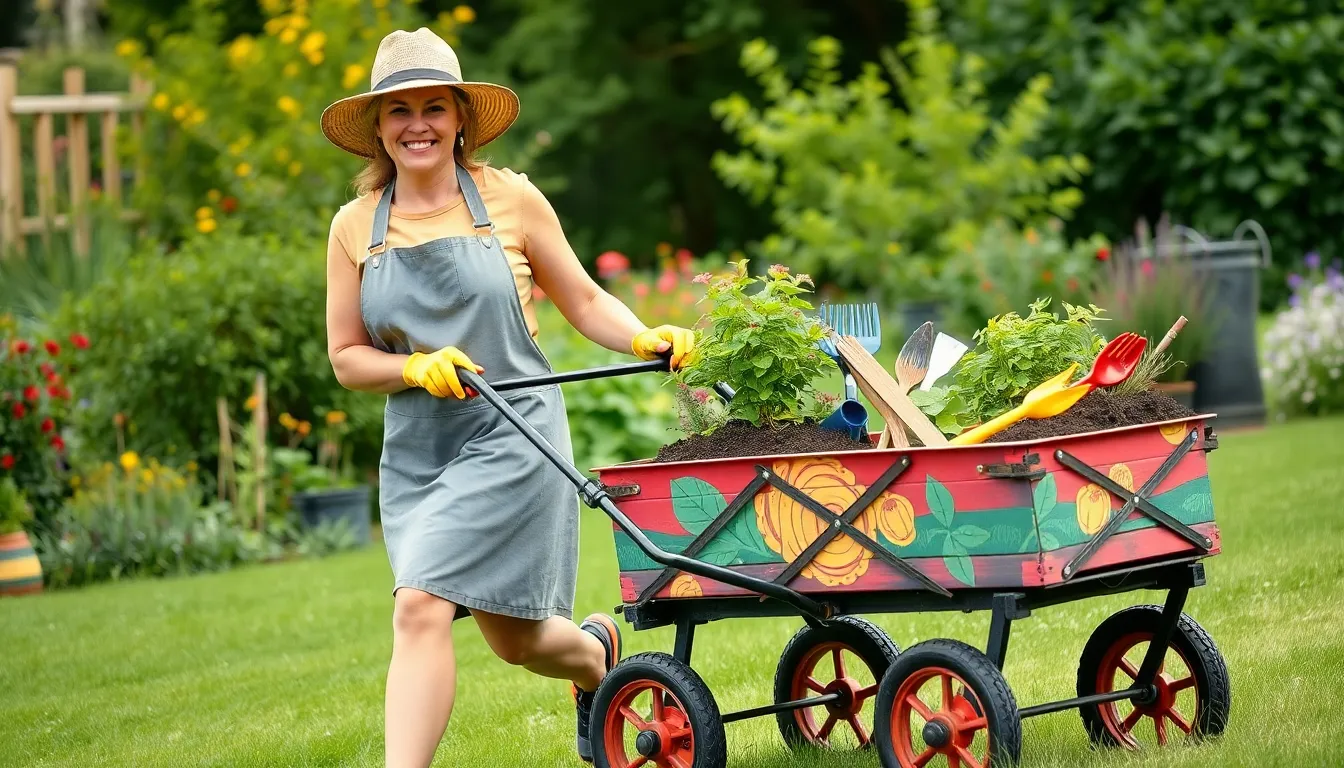Picture this: it’s a sunny Saturday morning, and your garden is bursting with potential. But wait! How on earth are you going to haul all those tools, plants, and maybe even a snack or two? Enter the gardening wagon, the unsung hero of the backyard. This trusty companion not only saves your back from the perils of heavy lifting but also adds a touch of charm to your gardening routine.
With a gardening wagon by your side, you’ll feel like a horticultural superhero. No more awkwardly juggling pots or making endless trips to the shed. Just load it up, and off you go! Whether you’re a seasoned green thumb or just starting out, a gardening wagon can transform your outdoor experience from chaos to calm—while keeping you organized and stylish. Who knew gardening could be this much fun?
What Is a Gardening Wagon?
A gardening wagon is a versatile and practical tool designed for transporting gardening supplies. It typically features sturdy wheels and a spacious bed, allowing users to carry tools, plants, and soil efficiently. These wagons enhance mobility around the garden, making tasks like weeding and planting easier.
Many gardening enthusiasts appreciate the ergonomic design of gardening wagons. By minimizing the need to lift heavy items, these wagons reduce strain on the back and arms. Some models include adjustable handles for personalized comfort, catering to users of varying heights.
Gardening wagons come in various styles and sizes. Some offer collapsible features for convenient storage, while others include built-in compartments for organizing tools. Users can find metal or plastic constructions, with the choice often depending on durability or weight preferences.
Safety features, like wheel locks, add stability during transport. This is particularly beneficial when hauling loads on uneven terrain. Additionally, gardening wagons can double as seating, providing a place to rest while working.
Overall, a gardening wagon serves as an essential asset for anyone engaged in gardening activities. By keeping tools and plants organized, it streamlines the gardening process and promotes a smoother, more enjoyable experience.
Benefits of Using a Gardening Wagon

Gardening wagons offer numerous advantages that enhance the gardening experience. They boost efficiency and comfort while reducing exertion.
Enhanced Mobility
Mobility improves significantly with a gardening wagon. Gardeners can move around the space more easily, navigating tight spots and uneven surfaces. Sturdy wheels provide stability on various terrains, ensuring smooth transportation of items. Tasks like weeding and planting become less strenuous, as one can carry heavy supplies without physical strain. Speed increases when gardeners transport multiple items in one trip, leading to time savings. Convenience becomes apparent, especially when carrying soil, plants, and tools, all in one load.
Improved Organization
Organization reaches new heights with a gardening wagon. Gardeners can arrange tools and supplies neatly in a spacious bed, reducing clutter. Various models feature built-in compartments, allowing for distinct separation of items. Easy access to tools fosters efficiency during tasks, cutting down on time wasted looking for misplaced items. Enhanced organization contributes to a more enjoyable gardening experience, promoting focus on creativity and cultivation. Compact designs in collapsible options facilitate storage when not in use, supporting maintenance of a tidy garden area.
Key Features to Consider
When selecting a gardening wagon, several key features enhance functionality and usability. Evaluating these aspects ensures gardeners choose the right wagon for their needs.
Size and Capacity
Size plays a crucial role in choosing a gardening wagon. Smaller models may suit limited spaces while larger options accommodate more supplies. Capacity directly affects how much equipment can be transported at once. Most wagons offer weight limits between 150 and 500 pounds, depending on design. For extensive gardening tasks, a larger capacity wagon saves multiple trips. Additionally, collapsible models offer versatility, allowing easy storage when not in use.
Durability and Material
Durability significantly affects the lifespan and performance of a gardening wagon. Steel and aluminum frames provide strength and resistance to wear. High-quality materials ensure the wagon withstands heavy loads and rough terrain. Weather-resistant fabrics also protect against moisture and UV rays, prolonging the wagon’s usability. Rust-resistant coatings enhance durability further, making maintenance minimal. Couples these factors with thoughtful design, and gardeners benefit from wagons that remain reliable over time and consistent usage.
Types of Gardening Wagons
Gardening wagons come in various styles, each tailored to specific gardening needs. Understanding these types helps gardeners select the right tool for their tasks.
Traditional Wagons
Traditional wagons feature a simple design, often consisting of a wooden or metal frame with a flatbed area. These wagons provide stability for transporting larger items like bags of soil, plants, and gardening tools. Some models include removable sides, allowing for customization based on load size. Durability is key, as most traditional wagons use robust materials to handle heavy weights, typically between 200 to 400 pounds. Gardeners appreciate the classic aesthetic they add to outdoor spaces, enhancing both functionality and style.
Folding Wagons
Folding wagons offer unique advantages, primarily convenience and portability. These models collapse easily, making storage simple when not in use. Lightweight frames usually support a variety of gardening supplies, with capacity ranging from 150 to 300 pounds. Many folding wagons feature built-in compartments for organizing tools, enhancing access while working in the garden. Their compact design allows easy movement through narrow paths, ensuring efficient transportation. Gardeners find that these wagons adapt well to various tasks, from carrying mulch to transporting potted plants.
Maintenance Tips for Gardening Wagons
Maintaining a gardening wagon ensures it remains functional and reliable. Regular cleaning helps prevent dirt and debris buildup. Using a damp cloth to wipe down surfaces keeps the wagon looking new.
Inspecting the wheels is crucial for its mobility. Checking for dirt or damage ensures smooth operation. Lubricating wheel bearings with a silicone spray enhances movement and extends wheel life.
Safeguarding the frame from rust involves applying a protective coating. A weather-resistant tarp can shield the wagon from the elements. Storing the wagon in a dry, covered area prevents deterioration.
Checking the handles for wear or looseness promotes safety during use. Tightening screws or bolts that hold the handle ensures stability. Replacing degraded materials promptly maintains the wagon’s integrity.
Inspecting the fabric, if applicable, for tears or wear protects items stored inside. Patching small tears keeps the contents secure. Consider replacing fabric sections that show significant damage for continued use.
Alternating the load carry helps distribute wear evenly over time. Avoiding overloading the wagon prevents strain on the frame and wheels. Staying within the manufacturer’s weight limit, which typically ranges from 150 to 500 pounds, promotes longevity.
By following these maintenance tips, gardeners can ensure their wagons remain effective tools in their gardening endeavors. Regular care not only prolongs the lifespan but also enhances the overall gardening experience.
Conclusion
A gardening wagon is more than just a tool; it’s a game changer for anyone passionate about gardening. With its ability to reduce physical strain and improve organization, it transforms the gardening experience into something more enjoyable and efficient.
Choosing the right wagon tailored to specific needs can enhance mobility and streamline tasks. Whether it’s a traditional wagon for heavy loads or a collapsible model for easy storage, the right choice makes all the difference.
By investing in a quality gardening wagon and following proper maintenance tips, gardeners can ensure that this essential tool serves them well for years to come. Embracing this versatile asset can lead to a more productive and satisfying gardening journey.




